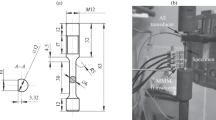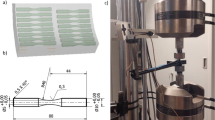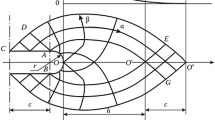Abstract
The paper investigates the mechanical and physical properties of low-carbon pipe steel (analog of steel 20 corresponding to TU-28-FR-73) after 39 years of service life in a crude gas pipeline at the Orenburg oil and gas condensate field. It is shown that the standard mechanical properties of the gas pipeline steel after long-term operation correspond to the TU-28-FR-73 standard. The effect of preliminary cyclic loading on the residual tensile strength of steel, the acoustic emission characteristics, and the residual magnetic field intensity estimated by the metal magnetic memory method is studied. After preliminary cycling, the steel was hardened and the acoustic regime changed due to damage accumulation. Four stages of damage evolution in the tensile steel are identified both before and after preliminary cyclic loading, and informative diagnostic criteria for the stages are proposed. Relationships are derived to relate the relative number of preloading cycles with the cumulative acoustic count, acoustic activity, slope of cumulative count-strain curves, acoustic gap duration, and residual magnetic field intensity. The listed characteristics are shown to be promising as diagnostic criteria for the state of the material.









Similar content being viewed by others
Change history
31 August 2021
Corrected issue title
REFERENCES
Panin, V.E., Likhachev, V.A., and Grinyaev, Yu.V., Structural Levels of Deformation of Solids, Yanenko, N.N., Ed., Novosibirsk: Nauka, 1985.
Panin, V.E. and Grinyaev, Yu.V., Physical Mesomechanics: A New Paradigm at the Interface of Solid State Physics and Solid Mechanics, Phys. Mesomech., 2003, vol. 6, no. 4, pp. 7–32.
Panin, V.E., Egorushkin, V.E., and Panin, A.V., Physical Mesomechanics of a Deformed Solid as a Multilevel System. I. Physical Fundamentals of the Multilevel Approach, Phys. Mesomech., 2006, vol. 9, no. 3–4, pp. 9–20.
Panin, S.V., Bashkov, O.V., Semashko, N.A., Panin, V.E., and Zolotareva, S.V., Combined Study of Deformation Peculiarities of Flat and Notched Specimens at the Micro- and Mesolevels by Means of Acoustic Emission Method and Surface Strain Mapping, Fiz. Mezomekh., 2004, vol. 7, spec. iss., part 2, pp. 303–306.
Gafarov, N.A., Goncharov, A.A., and Kushnarenko, V.M., Reliability Characteristics and Technical Condition of Equipment for Hydrogen Sulfide-Containing Oil and Gas Fields, Moscow: Nedra, 2001.
Bochkarev, G.I., Gafarov, N.A., Mitrofanov, A.V., Pavlovskii, B.R., Braginskii, A.N., and Shemyakin, V.V., Recommendation on the Use of Acoustic Emission Diagnostics of Technological Equipment and Pipelines of Gas Chemical Complexes, Moscow: Gazprom IAC, 1997.
Strizhalo, V.A., Dobrovolskii, Yu.V., Strelchenko, V.A., Pichkov, S.N., and Danilin, V.V., Strength and Acoustic Emission of Materials and Structural Elements, Pisarenko, G.S., Ed., Kiev: Naukova Dumka, 1991.
Nazarchuk, Z.T. and Skalsky, V.R., Acoustic Emission Diagnostics of Structural Elements: Engineering Handbook. V. 2. Methodology of Acoustic Emission Diagnostics, Kyiv: Naukova Dumka, 2009.
Mazal, P., Vlasic, F., and Koula, V., Use of Acoustic Emission Method for Identification of Fatigue Micro-Cracks Creation, Proc. Eng., 2015, vol. 133, pp. 379–388. https://doi.org/10.1016/j.proeng.2015.12.667
Triantis, D., Acoustic Emission Monitoring of Marble Specimens under Uniaxial Compression. Precursor Phenomena in the Near-Failure Phase, Proc. Struct. Integr., 2018, vol. 10, pp. 11–17. https://doi.org/10.1016/j.prostr.2018.09.003
Shiotani, T., Yuyama, S., Li, Z.W., and Ohtsu, M., Application of AE Improved B-Value to Quantitative Evaluation of Fracture Process in Concrete Materials, J. Acoust. Emiss., 2001, vol. 19, pp. 118–133.
Botvina, L.R., Petersen, T.B., and Tyutin, M.R., Estimation and Analysis of Acoustic Emission Parameter b, Zavod. Lab. Diag. Mat., 2011, vol. 77, no. 3, pp. 43–50.
Dubov, A.A., A Study of Metal Properties Using the Method of Magnetic Memory, Met. Sci. Heat Treat., 1997, vol. 39, no. 9–10, pp. 401–405.
Gorkunov, E.S., Different Remanence States and Their Resistance to External Effects. Discussing the “Method of Magnetic Memory”, Russ. J. Nondestr. Test., 2014, vol. 50, no. 11, pp. 617–633.
Roskosz, M., Metal Magnetic Memory Testing of Welded Joints of Ferritic and Austenitic Steels, NDTE. Int., 2011, vol. 44, no. 3, pp. 305–310. https://doi.org/10.1016/j.ndteint.2011.01.008
Shi, C.L., Dong, S.Y., Xu, B.S., and He, P., Metal Magnetic Memory Effect Caused by Static Tension Load in a Case-Hardened Steel, J. Magn. Magn. Mater., 2010, vol. 322, no. 4, pp. 413–416. https://doi.org/10.1016/j.jmmm.2009.09.066
Zhang, Y.L., Gou, R.B., Li, J.M., Shen, G.T., and Zeng, Y.J., Characteristics of Metal Magnetic Memory Signals of Different Steels in High Cycle Fatigue Tests, Fatigue Fract. Eng. Mater. Struct., 2012, vol. 35, no. 7, pp. 595–605. https://doi.org/10.1111/j.1460-2695.2012.01651.x
Huang, H., Jiang, S., Liu, R., and Liu, Z., Investigation of Magnetic Memory Signals Induced by Dynamic Bending Load in Fatigue Crack Propagation Process of Structural Steel, J. Nondestruct. Eval., 2014, vol. 33, no. 3, pp. 407–412. https://doi.org/10.1007/s10921-014-0235-y
En, Y., Luming, L., and Xing, C., Magnetic Field Aberration Induced by Cycle Stress, J. Magn. Magn. Mater., 2007, vol. 312, no. 1, pp. 72–77. https://doi.org/10.1016/j.jmmm.2006.09.019
Xu, M., Chen, Z., and Xu, M., Micro-Mechanism of Metal Magnetic Memory Signal Variation during Fatigue, Int. J. Miner. Metall. Mater., 2014, vol. 21, no. 3, pp. 259–265. https://doi.org/10.1007/s12613-014-0903-z
Wang, Z.D., Gu, Y., and Wang, Y.S., A Review of Three Magnetic NDT Technologies, J. Magn. Magn. Mater., 2012, vol. 324, no. 4, pp. 382–388. https://doi.org/10.1016/j.jmmm.2011.08.048
Makhutov, N.A., Dubov, A.A., and Denisov, A.S., Investigation of Static and Cyclic Deformation Using the Metal Magnetic Memory Method, Zavod. Lab. Diag. Mat., 2008, vol. 74, no. 3, pp. 42–46.
Roskosz, M. and Gawrilenko, P., Analysis of Changes in Residual Magnetic Field in Loaded Notched Samples, NDTE. Int., 2008, vol. 41, no. 7, pp. 570–576. https://doi.org/10.1016/j.ndteint.2008.04.002
Hu, Z., Fan, J., Su, X., Gao, F., and Xin, K., Early Inspection of Drill String Fatigue Damage Based on Metal Magnetic Memory Method, in 19th World Conference on Non-Destructive Testing, 2016, pp. 121–127.
Huang, H., Jiang, S., Yang, C., and Liu, Z., Stress Concentration Impact on the Magnetic Memory Signal of Ferromagnetic Structural Steel, Nondestruct. Test. Eval., 2014, vol. 29, no. 4, pp. 377–390. https://doi.org/10.1080/10589759.2014.949710
Bauer, A.A., Kushnarenko, V.M., Pyataev, A.E., Chirkov, Yu.A., and Shchepinov, D.N., Reliability of Pipelines Transporting Hydrogen Sulfide-Containing Oil and Gas Media, Orenburg: OrenPechat’, 2018.
Botvina, L.R., Tyutin, M.R., Petersen, T.B., Prosvirnin, D.V., Morozov, A.M., and Kolokolov, E.I., Residual Strength of Cyclically Deformed Corrosion-Resistant Steel, Russ. Metall. (Metally), 2020, vol. 2020, no. 4, pp. 483–492.
Botvina, L.R., Tyutin, M.R., Bolotnikov, A.I., and Petersen, T.B., Effect of Preliminary Cycling on the Acoustic Emission Characteristics of Structural 15Kh2GMF Steel, Russ. Metall. (Metally), 2021, vol. 2021, no. 1, pp. 32–41. https://doi.org/
Rybakova, L.M., Mechanical Properties and Damage in a Plastically Deformed Metal, Vest. Mashinostr., 1993, no. 3, pp. 32–37.
Berezin, A.V., Kozinkina, A.I., and Rybakova, L.M., Acoustic Emission and Destruction of Inelastically Strained Metal, Russ. J. Nondestr. Test., 2004, vol. 40, no. 3, pp. 152–156.
Botvina, L.R. and Tyutin, M.R., New Acoustic Parameter Characterizing Loading History Effects, Eng. Fract. Mech., 2019, vol. 210, pp. 358–366. https://doi.org/10.1016/j.engfracmech.2018.06.020
Ivanova, V.S. and Terent’ev, V.F., The Nature of Metal Fatigue, Moscow: Metallurgiya, 1975.
Jiles, D.C., Theory of the Magnetomechanical Effect, J. Phys. D. Appl. Phys., 1999, vol. 32, no. 15, pp. 1945–1945. https://doi.org/10.1088/0022-3727/32/15/501
Funding
This work was supported by the Russian Science Foundation (project No. 19-19-00674).
Author information
Authors and Affiliations
Corresponding author
Rights and permissions
About this article
Cite this article
Botvina, L.R., Kushnarenko, V.M., Tyutin, M.R. et al. Fracture Stages and Residual Strength of Pipe Steel after Long-Term Operation. Phys Mesomech 24, 475–485 (2021). https://doi.org/10.1134/S1029959921040123
Received:
Revised:
Accepted:
Published:
Issue Date:
DOI: https://doi.org/10.1134/S1029959921040123




